Mata Hari
![]()
The title of this article is ambiguous. For other meanings, see Mata Hari (disambiguation).
Mata Hari (Malay "sun", literally "eye of the day") was the stage name of Dutch dancer Margaretha Geertruida Zelle (b. 7 August 1876 in Leeuwarden; † 15 October 1917 in Vincennes near Paris, France). During her marriage she also used the names Marguerite Campbell and Lady Gretha MacLeod. As a spy for the German intelligence service, she used the code name H 21.
Mata Hari was famous as an exotic nude dancer and eccentric artist in the time before and during the First World War. In addition, she became known as a German spy. She was sentenced to death for double espionage and high treason by the judges of a French military court on July 25, 1917, and executed in Vincennes on October 15.
Mata Hari was never the sophisticated double agent stylized in the 1917 verdict and later portrayals - rather a welcome pawn of the French military court, because the enthusiasm for war was noticeably waning and a scapegoat for the defeats and losses seemed helpful. Mata Hari entered the service of German intelligence III b in the late autumn of 1915 and was additionally recruited by French intelligence for activities against the German Reich the following year. However, from the contemporary files of the British Security Service (MI 5), declassified on January 21, 1999, and now publicly available in the British The National Archives, it appears that she did not betray any essential secrets, either to the Germans or the French - she did not have the contacts in neuralgic military or wartime areas. From the current sources it seems as if Mata Hari, at the end of her dancing career, tried to avert her impending fate of being forgotten as an artist and suffering from acute financial hardship with a pitifully naïve, meaningless information activity, not realizing the dangerous nature of her actions.
German war propaganda in the First World War, which intended to exploit the case, called her a "victim of the French war mania" and heralded its dramatic-romantic transfiguration with the political finale of the idol. To date, her life story has been the subject of over 250 books and a dozen films. The source material remains thin, however, with only a fraction of these books and films based on reliable sources or inclined to confront the actual historical events.

Mata Hari (1906)
Artist name
The stage name Mata Hari comes from the Malay language and means "sun" or literally translated "eye" (mata) of the "day" (hari). After initial successes as a dancer, Margaretha Geertruida MacLeod adopted this name in 1905, indirectly supporting rumors spread in the press that she was the daughter of an Oriental ruler.
Dance Career
Legends
Between 1903 and 1905, Margaretha MacLeod created her veil dance and costume and legend of an Indian temple dancer, which fell on fertile ground with her audience. Since there were few experts on Indian or Javanese dances and culture, she had little to fear from debunking her fantasy stories, lies, and fibs. Belle Époque Paris was used to foreign and frivolous dancers; however, an Indian bayadere who could boast of a mysterious history and exotic origins was something new. The "better society" of Paris was always on the lookout for sensations and interesting entertainment. The story and the dance of Mata Hari fascinated the rich and bored public. In addition, Margaretha perfectly mastered "the art of erotic undressing".
"Paris had not seen anything like it ... graceful gestures became passionate coils - and in the end a naked beauty stood before the rapt ladies and gentlemen of society."
- DER SPIEGEL current affairs
A journalist wrote as a contemporary witness in the Courrier français:
"A tall dark figure floats in. Strong, brown, hot-blooded. Her dark complexion, full lips and glistening eyes bear witness to lands far away, to scorching sun and tropical rain. She sways under the veils that at once veil and reveal her. [...] The spectacle can be compared to nothing we have ever seen. Her breasts rise languidly, her eyes glisten moistly. Her hands rise and fall again, as if they were slack from the sun and the heat. [...] Her worldly dance is a prayer; lust becomes worship. What she implores we can only guess [...] The beautiful body pleads, writhes, and surrenders: it is, as it were, the dissolution of desire in desire."
- Marcel Lami in the "Courrier français"
From then on, Margaretha posed as an exotic, claiming that she came from the south of India, from the Malabar coast, from the holy city of Jaffnapatam (which is not on the Malabar coast at all, but on Ceylon), and that her family consisted of members of the upper caste of Brahmins. She had grown up in the subterranean hall of the god Shiva and had been taught from childhood the ritual temple dances, which she had danced day after day in honour of the gods. She would have indulged in magnificent gardens, garlanded with garlands of jasmine and decorated the altars of the gods. She would probably have spent her whole life in this place if a beautiful young British officer had not once seen her at such a dance, fallen madly in love with her, kidnapped her and married her. She then bore him a son, Norman, whom a fanatical servant poisoned for no reason. She in turn - according to Indian custom - strangled the servant with her own hands.
This legend she occasionally changed. Often she located her childhood in Java. She often claimed to be the granddaughter of a Javanese sultan whose daughter had married a Dutch officer. At the age of two she had come to Germany to a boarding school and, at 16, had married the British officer MacLeod.
Mata Hari's exotic origin was still considered a fact until the end of the 1920s. Although partial doubts about her life story arose early on, among others by the French writer and dancer Colette, Mata Hari's legend of her Indian or Indonesian origin was not revealed until 1930 by the journalist Charles S. Heymans. Her birthplace, her parents and the circumstances that made her a dancer remained her well-kept secret until then, known only to a few.
Mata Hari had spent some years in Indonesia, but had neither learned Indian dances nor dealt with them more intensively. What she knew of Indian dances and love arts, she probably took from a translation of the Kamasutra and modified it for her purposes. Margaretha had had no opportunity to take a direct insight into the world of Hinduism, within which the tradition of temple dancing had developed. She had never been to India, and in Indonesia this tradition is unknown.
But she could tell whatever she wanted, people believed her unreservedly; it was precisely this mysterious-exotic touch that had an effect on her experience-hungry audience and paved the way for her success. She became a sensation. The newspapers wrote about her, the critics practically overflowed with their compliments, she was on everyone's lips, tout Paris (all of Paris) wanted to see her. Her triumphal procession as a celebrated dancer began.
· Hand coloured postcard series by Lucien Walery from 1906
· 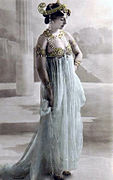
· 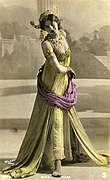
· 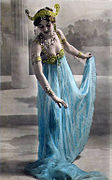
· 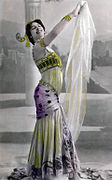
· 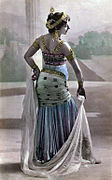
· 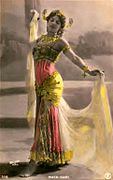
· 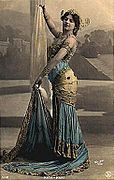
· 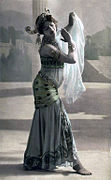
The dancer Mata Hari
According to research by Jan Brokken, at the time of her second stay in Paris she danced a snake dance in a bar in Montmartre, where she had been noticed and invited to perform at a charity event in the renowned salon of Madame Kiréevsky. The performance took place at the end of January 1905, she was announced as Lady MacLeod. Through press releases announcing "a woman from the Far East" who "came to Europe laden with perfume and jewels to veil and unveil herself", further patrons became interested in Lady MacLeod.
"Lady Mac Leod, whose name will soon be known throughout Paris, brought with her from India, where she was married to a high officer, temple dances based on rather idiosyncratic legends. At the diner de faveur at Julien's, presided over by Marthe Régnier of the Vaudeville, as well as Monsieur Tauride, the director of the Odéon, our colleague Georges Visinet read in his powerful voice the invocation to the god Shiwa. [...] With remarkable suppleness Lady Mac Leod offers these dances, which are really worth seeing, and which are enthusiastically received in clubs and salons. The danced legend of the princess and the enchanting flower received great applause."
- Le Courrier français of 9 February 1905
At the invitation of the industrialist Émile Guimet, who had followed her performance at the Salon Kiréevsky, she danced before a select audience at his Guimet Museum on 13 March 1905, presenting recreations of Indian temple dances. He provided her with suitable dancewear, a sarong and embroidered bustier, veil and jewellery, and advised her to adopt a stage name. Although she was still announced in the newspapers as Lady Mac Leod, she settled on her final stage name that day - Mata Hari. Matahari means "sun" in Malay (literally "eye of the day").
The scene in which she last danced almost unclothed was both a sensation and a scandal. It was followed by appearances at the soirées of banker Baron Henri de Rothschild (1872-1946), the stage actress Cécile Sorel (1873-1966), Gaston Menier, heir to the Menier chocolate dynasty, Natalie Clifford Barney and many others.
The year 1905 was the most successful for Mata Hari. She gave 35 performances, earned around 10,000 French francs per evening, frequented the most expensive hotels and lived in her own apartment at number 3 Rue Balzac in the 8th arrondissement of Paris. In May she succeeded in a performance at the Théâtre du Trocadéro, which she repeated in June and July. She was also contacted by the newspaper editor and impresario Gabriel Astruc, who was preparing a vaudeville programme for the Olympia Theatre and invited her to be the main attraction.
At the end of the year she announced to a Dutch journalist that she would give up dancing and marry an Eastern European prince. Such and similar false reports, apparently deliberately placed by Mata Hari, ensured that the public's interest in the mysterious dancer never waned. Nevertheless she had to fight with competition already after a short time. Suzy Deguez, dancer in the Folies Bergère, copied her "temple dances", soon followed by other dancers. Mata Hari reacted outwardly calmly, promising extraordinary sensations that she would soon bring to the stage. The interest in her, especially as an advertising icon, remained unbroken despite the burgeoning competition. The big vaudevilles booked her, one engagement followed the other, her image appeared on postcards, cigarette packets and biscuit tins.
Her first engagement abroad took her to Spain in 1906 to the Central Kursaal in Madrid. Here she met the French ambassador Jules Cambon. This acquaintance did not save her life later, but Cambon was the only one who testified in her favor at her trial in 1917 and did not hide.
In the same year, she appeared in front of a large audience at the Olympia Theatre in Paris as part of a vaudeville programme. In Monte-Carlo she was seen in the third act of Jules Massenet's opera Le roi de Lahore as Salomé alongside the ballerina Carlotta Zambelli (1875-1968).
On April 26, 1906, a divorce decree was issued for her marriage. Mata Hari was divorced guilty because of nude photos which she had made for a sculptor and which were sold to lovers for unexplained reasons and thus circulated in public. Her public did not learn of this event, she continued to pretend to be the mysterious Indian temple bayadere Mata Hari, about whose romantic origins the newspapers trumped each other with fantastic stories.
After her triumphant performance in Monte-Carlo, Mata Hari traveled to Vienna for performances at the Apollo Theater, where she also enjoyed great success. The newspapers were full of enthusiastic criticism:
"Isadora Duncan is dead, long live Mata Hari! The barefoot dancer is vieux jeu, the artist up to date shows more [...] Mata Hari's dances are a prayer ... the Indian dances when he honors the gods. Mata Hari herself enters with a measured stride. A Junonian apparition. Large, fiery eyes give special expression to her nobly cut face. The dark complexion - apparently heirloom from Grandpapa Regent - dresses her magnificently, an exotic beauty of the first order. A white wrinkled shawl wraps her, a red rose adorns the jet-black hair. And Mata Hari dances [...] That is: she does not dance. She performs a prayer before the idol, like a priest performs the service. [...] Under the veil, the beautiful dancer wears on her upper body a breast ornament and a gold belt ... nothing else. The boldness of the costume forms a small sensation. But not the faintest semblance of independence... That which the artist reveals in the dance is purest art. The dance concludes with the victory of love over restraint [...] the veil falls. There is a mighty round of applause. But already Mata Hari has disappeared."
- Neues Wiener Journal of 15 December 1906
She came to Berlin for the first time in 1907 for a performance at the Varieté Wintergarten on Friedrichstraße and became a sensation here as well. Afterwards she is said to have lived in Berlin for several months with the Marienfeld manor owner Alfred Kiepert, a wealthy lieutenant of the "Eleventh Hussar Regiment of Westphalia", at Nachodstraße 18. In the meantime, the first rumors about her true identity surfaced, and Mata Hari defended herself in the press with an altered life story: "He (Mata Hari's father) was a career officer. He raised me in Java and then sent me to an aristocratic boarding school in Wiesbaden."
In Berlin she also gave a performance for the German Emperor Wilhelm II and his family. Another rumor reported about a relationship of the dancer with the son of the emperor. This was not denied by her, which should be interpreted negatively in her trial.
She returned to Paris in 1907. In the same year the book Mata-Hari - Mevr. M.G. Mac Leod-Zelle, written by her father Adam, was published. De levensgeschiedenis mijner dochter en mijne grieven tegen haar vroegeren echtgenoot. Met portretten, documenten, fac-simile's en bijlagen. This "life story" contained, in addition to forged documents with which the father wanted to prove a noble descent of his daughter, above all accusations against her ex-husband.
In the winter of 1907, she went on a trip to Egypt - possibly with Alfred Kiepert - and remained lost to her European followers. Rumor had it that she was "staying in the Nillande to study the ancient mysteries". On March 30, 1907, Mata Hari was in Rome and telegraphed her manager to see if any new engagements had arrived for her in the meantime. She also wrote to Richard Strauss to propose herself for his new production as Salome: "Only I can dance Salome." When she received no reply, she traveled back to Paris.
Career Break
Once in France, Mata Hari found that she had almost been forgotten as an artist and that Paris was teeming with copies of her dances. The dancer Colette could be seen almost naked in The Egyptian Dream at the MoulinRouge, in Berlin the Moroccan dancer Sulamith Raha in "Eva costume" showed her sword dance, the veil dance and a belly dance, and Maud Allan successfully toured Europe with her Visions of Salome. In response, Mata Hari announced her retirement from the stage in the September 20, 1908 issue of the British The Era, a weekly newspaper devoted to arts and culture, complaining about her competitors, "Since then some ladies have claimed the title of Oriental dancers. I might be flattered by such evidence of attention if the performances of these ladies possessed some scientific and aesthetic value, but this is not the case."
But her star had not yet sunk. She was still a valued member of Parisian society, and the newspapers reported on her regularly. She danced more frequently again at charity events, such as the Trocadéro, the Pont aux Dames and the Houlgate.
In 1910, she took on the role of Cleopatra in Antar by Nikolai Andreyevich Rimsky-Korsakov in Monte-Carlo. But Antoine, the inventor of realistic theatre and director of the play, was dissatisfied with her performance as a dancer. When she expected to be hired by Antoine to perform Antar at his own theater on the Boulevard de Strasbourg as well, she was disappointed. Journalists quickly became aware of the dispute between the director and the dancer, and each fed the other's statements to the press. Mata Hari took legal action for libel and claimed damages. Antoine then counter-sued Mata Hari. The trial dragged on until December 1911; Mata Hari won. Her honour was restored, but there were no further engagements in the following time.
From the summer of 1910 until the end of 1911, she lived - unnoticed by the public - together with her maid Anna Lintjes in Esvres, France, in the chateau de la Dorée of the married banker Xavier Rousseau, whose mistress she was. After this affair, she again had to provide for her own livelihood and again sought increased contact with Astruc, who was indeed able to get her a number of new engagements, including the performance that was later understood to be the high point of her career: On December 7, 1911, she danced The Princess and the Magic Flower in the fifth act of Christoph Willibald Gluck's opera Armide at La Scala in Milan, and in January 1912 she embodied Venus in Antonio Marceno's ballet Bacchus and Gambrinus. While Venus was otherwise portrayed by female artists with blonde hair, Mata Hari appeared with her own dark hair as the much acclaimed "Black Venus".
She also danced Salome in the private salons of the Italian upper class. In March 1912 she tried to get an engagement from Sergei Djagilew, who was enjoying fabulous success in Europe with his company, but was brusquely turned down. When she performed in Monte-Carlo, Djagilew and she had come into contact, and after she had enjoyed success as Black Venus, the idea of performing with the Ballets Russes arose in her in earnest. Djagilew stood her up at a meeting without apologising; this was followed by an éclat in the presence of his first dancer Vaslav Nijinsky, the choreographer Michel Fokine and Léon Bakst, while stage alterations were under way in the theatre. Djagilew demanded that Mata Hari undress and give a sample of her dancing skills on the stage, which was crowded with stagehands. Enraged, the 36-year-old left the theatre, convinced that she could perform as prima ballerina of Europe's leading ballet company at the time without any dance training and without sufficient experience in classical ballet.
Now and then she could still show her oriental dances in front of a larger audience. Thus, on 14 December 1912, she could be seen in the performance Indian Art at the Université des Annales. But her manager Astruc, who had become director of the Théâtre des Champs Elysées in the meantime, also turned away from her.
At this time, Mata Hari also tried to establish contact with her daughter Non, but her ex-husband returned her letters unopened. Finally, Mata Hari sent her closest confidante, the maid Anna Lintjens, to Holland. She was to possibly bring Non to her in Neuilly-sur-Seine, where Mata Hari had been living in her small villa since late 1911. This attempt at an undisturbed meeting with her daughter has been portrayed in some accounts as a planned kidnapping. Whether Anna Lintjes really had the mission to take Non to another city remains unclear. In any case, she returned to France without her daughter.
All that is known about Non's further life is that she intended to move to Indonesia in the autumn of 1919, two years after her mother's death, to work there as a teacher. However, only a few weeks before she was due to leave, she died of a cerebral haemorrhage at the age of just 21.
Mata Hari traveled to Berlin in 1913 and saw the German crown prince during a tour of the city. Her interest was misinterpreted by an observer named Guido Kreutzer as fanatical hostility toward Germany. Kreutzer documented his suspicions in a 1923 book, The German Crown Prince and the Women in His Life. When Mata Hari asked to be allowed to dance before the German Crown Prince, her request was not granted. So she left Berlin without having achieved anything.
On 28 June 1913, she appeared as a Spanish dancer in La Revue en Chemise at the Folies Bergère. At the Gaumont cinema, she performed her dance for the god Shiva for the last time. The zenith of her dance career had already passed. After three performances at the Musée Galliera in January 1914, she told a Vogue journalist that she was preparing a sensational comeback. She travelled back to Berlin and telegraphed Émile Guimet at the end of February asking if she could recreate her success with Egyptian dances. His reply of March 9, 1914, was telling: "Dearest, doing Egyptian ballet is an excellent idea, provided it is really Egyptian."

Historical photo of an Indian temple sculpture of the Hindu goddess Bhavani handing over her sword to Shivaji

Mata Hari, at the peak of her success
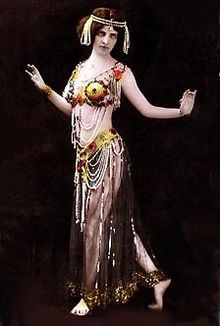
Maud Allan as Salome around 1906, in this picture a nearly perfect copy of Mata Hari
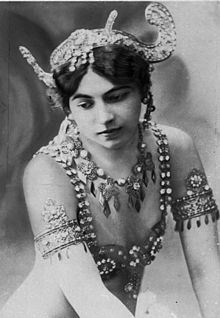
Mata Hari (c. 1907)
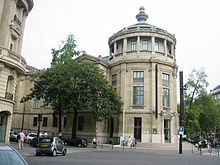
The Musée Guimet in Paris today
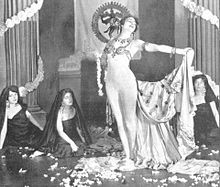
Mata Hari at the Musée Guimet (1905)

Mata Hari (c. 1906)
Search within the encyclopedia